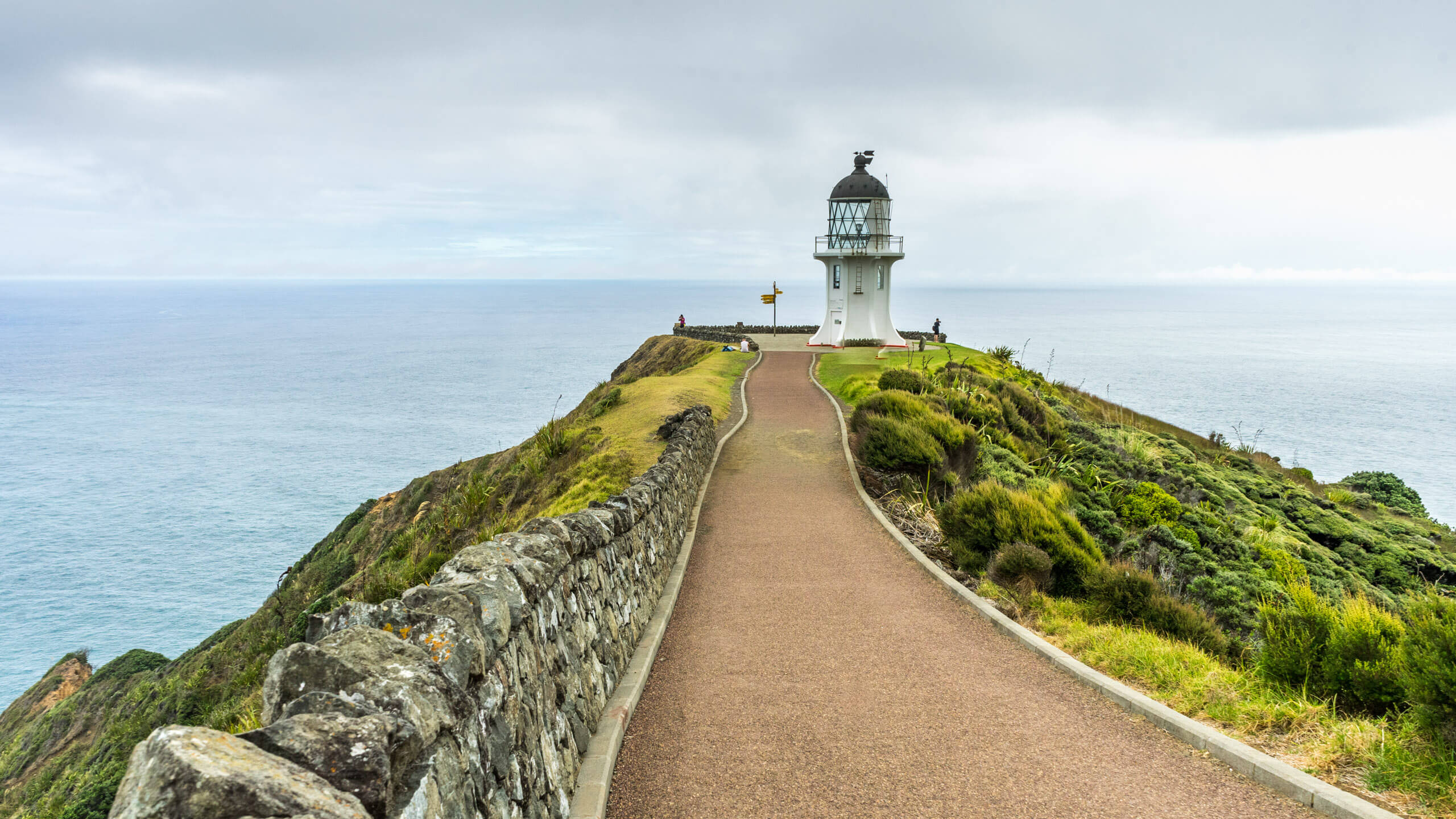Located at the extreme northwestern tip of the Aupouri Peninsula, Cape Reinga is positioned toward the northernmost end of New Zealand’s North Island, making it one of the country’s most northerly points. It is situated roughly 100 km away from the nearest small town of Kaitaia, and about 421 km north of Auckland.
We found the accommodation was sparse to nonexistent up this far north. So, we headed out from Whangerei, a four-hour drive away. We only discovered after we briefly stopped in Kawakawa that it had some famous quirky toilets. So, if you are stopping to grab a bite to eat and a coffee why not stop to explore? As we drove over the mountain range toward the Cape, we hit sea mist, and lots of it. Not off to a great start.
Even taking the DeHaze slider in Lightroom Classic all the way to the right, I still couldn’t bring out much more details in the photos. Thankfully, it had started to clear.
Cape Reinga Lighthouse
There is a good car park and then a lovely walk down to the lighthouse. It’s worth stopping to read the markers and historical facts posted along the walk. This area is known as The Meeting Point to the Mauri. The Cape Reinga Lighthouse was built in 1941 and was the last attended lighthouse in New Zealand (it replaced the Motuopao Island lighthouse built in 1879). These were the first lights that ships saw when arriving from the Tasman Sea and the northern Pacific Ocean. It’s made of concrete and stands 10 m tall, and can be seen 30 km offshore.
One of my favorite things about New Zealand is how orderly, well-kept and maintained, as well as very informative all of the tourist spots are. Plus, the locals are nice and very helpful. As luck had it, the sea mist cleared by the time we made it down the hill to the lighthouse and we got some fabulous views. Sadly, as we started to leave, the sea mist rolled back in and we got very wet walking back to the car. Thankfully it was not at all cold, as being cold, wet and miserable often makes for a long day.
Tapotupotu Bay
By now the sea mist had completely blown off and left us with brilliant blue skies and fluffy white clouds. Such a pretty spot and apparently, good for fishing too.
Te Paki Giant Sand Dunes
They’re not kidding, these dunes are huge and people were climbing up and then sliding down them, with hired boogie boards and toboggans. So much fun to watch, but I wasn’t about to join them! I tried to keep some size of the dunes, but still see the people sliding down them for an idea of just how big they really are. Fabulous spot to explore, but not much shade. It was getting quite hot under that sun; now the sea mist was completely gone. It was high summer after all.

90 Mile Beach
Our next stop was 90 Mile Beach. You can drive on the beach but need to be careful not to get stuck. Some areas are reportedly like quicksand and can swallow cars up past the axle; I’ve seen many photos. There is a local farmer who offers a towing service with his tractor — for a premium price, of course!
We only drove a little way and followed where others had been; we did not want to get stuck so soon in our adventure. Still, it was nice to be able to drive on the beach, something we do not really get to do here in Melbourne. The beach is quite flat and goes a long way. To be honest, apart from driving on the beach and taking photos of the hire car on the sand, it really wasn’t all that photogenic. But we had driven a long way to get here, may as well visit everything we could.
Gumdiggers Park
We then visited Gumdiggers Park, where they dug up really old (100,000) buried Kauri Tree Forest and amber. It was supposed to be really interesting, but really was just a hot dusty walk in the scrub. Not overly brilliant, not sure it is really worth the $12.50 entry either. Although I did get some fabulous dragonfly photos! But I guess some people may have found it more interesting than I did. Remembering New Zealand is a fairly young country, much like Australia, the colonial settlement only goes back 200 years or less. There is more history around Mauri’s culture, and to be honest probably more interesting.
From here we left Cape Reinga and returned to Whangarei. It was a long day, but absolutely fascinating with beautiful scenery. I think I popped my 28-75mm on my camera and left it there most of the day. Only taking it off to capture some lizards and dragonflies at Gumdiggers Park with my 18-200mm. Sadly, my 18-200mm is an APS-C and the images are smaller than I’d like.
Tips:
- If you are heading somewhere new, a little bit of research on the area is a great idea. Even speaking to locals or someone who has visited the area before will help.
- When going on long drives, make sure you have plenty of fuel, snacks and water.
- If heading down the coast, be prepared for anything, from blue sky and sunshine to heavy sea mist; Take jackets, hats, sunscreen and rain ponchos — be prepared!
- Check all camera gear is ready and packed the night before, including batteries, SD cards and lenses. Nothing worse than getting somewhere and finding you left the battery on the counter or the SD card in the reader!
Source link




Leave a Reply